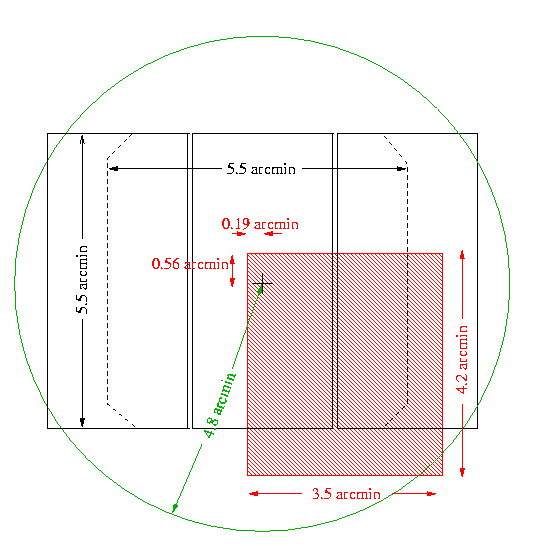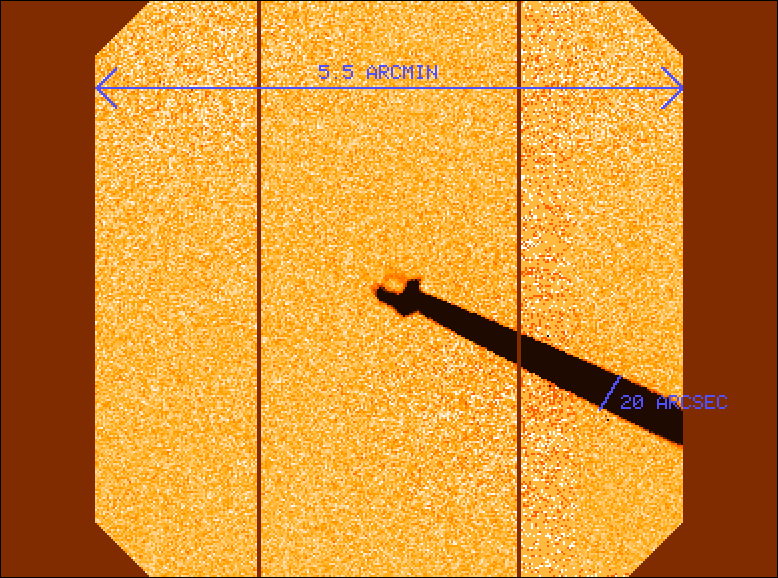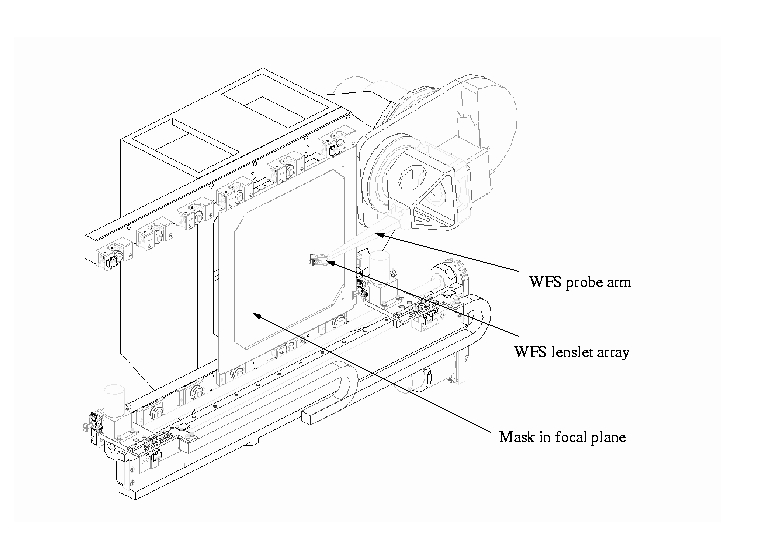![[GMOS logo]](gmoslogo.gif) |
GMOS OIWFS
|
The GMOS On-instrument Wavefront Sensor (OIWFS) consists of a 2x2
lenslet array on a moveable arm that patrols an area in front of the
mask plane. Signals from the OIWFS are fed to the secondary for fast
tip-tilt guiding.
The peripheral WFSs (PWFS) vignet
a large part of the GMOS science field. Further, there is significant
flexure between GMOS and the PWFSs, thus the PWFSs should not currently
be used with GMOS.
- Filter : GG495 (longpass filter with a blue cut-off at 495nm)
- Limiting magnitude and availability of guide stars
Guide stars for the OIWFS need to be fainter than V=9.5mag.
Some limiting magnitude measurements for the OIWFS have been carried out during
the commissioning; more are still planned. The table below gives the overview
if the limiting magnitudes in photometric conditions and with low wind. The results
are given as the limiting magnitude for a given observing condition and guide
frequency. For programs that can be carried out in non-photometric conditions,
the guide stars need to be sufficiently bright to enable guiding through the clouds.
The limiting magnitude for the the OIWFS also depends on the seeing and the wind.
In moderate to high wind the guide frequency needs to be at least 100Hz,
while 50Hz is useful in low wind, only. Further, high wind makes the intial acquisition
of a faint guide star a time consuming task, adding to the effective overhead
at the time of observation.
For the purpose of planning observations for the current semester, it is required
that the guide star magnitudes are brighter than V=16 mag for guiding
on dark sky in seeing conditions of 70-percentile or better.
For guiding in moon light under the same seeing conditions, guide stars need to
be brighter than V=15.0 mag. For programs that can executed in poorer seeing
conditions, guide stars that are 1-2 magnitudes brighter are needed.
The users are encouraged to select guide stars as bright as possible.
| OIWFS limiting (V) magnitudes |
| Seeing |
Dark sky |
Full moon |
| < 0.75arcsec |
200Hz 15.5 mag
100Hz 16.2 mag
50Hz 17.1 mag |
200Hz 15.0 mag
100Hz 15.3 mag
50Hz 15.5 mag |
| 1.5arcsec |
200Hz 13.8 mag
100Hz 14.9 mag
50Hz 15.5 mag |
Estimate
100Hz 13.0 mag |
- Patrol field : 3.54 arcmin x 4.15 arcmin = = 14.7 sq arcmin,
overlapping one corner of the imaging field with some area outside
the imaging field. The patrol area is the red box on the schematic diagram below.
The patrol area is effectively doubled since the field can be rotated 180 degrees.
The OIWFS cannot patrol outside a circle with radius 4.8 arcmin; the green
circle on the schematic diagram below. Thus a small
area in the lower right of the patrol area shown on the schematic cannot
be reached.
 Schematic diagram of the patrol area of the OIWFS (red box)
relative to the GMOS CCD array (which consists of three chips). The
imaging field is shown by the dashed line.
The OIWFS cannot patrol outside a circle with radius 4.8 arcmin (the green circle).
Schematic diagram of the patrol area of the OIWFS (red box)
relative to the GMOS CCD array (which consists of three chips). The
imaging field is shown by the dashed line.
The OIWFS cannot patrol outside a circle with radius 4.8 arcmin (the green circle).
- Vignetting of GMOS science field by OIWFS :
An image showing the vignetting of the GMOS science field by the
OIWFS is shown below. The OIWFS on that image is in the center of
the field, just for illustration. The OIWFS can be placed anywhere in
the patrol field outlined on the diagram above, including outside the
imaging field.

Vignetting of GMOS science field by OIWFS, if the OIWFS is in the
center of the imaging field. The imaging field of view of 5.5 arcmin is
shown. The width of the OIWFS arm as seen by the GMOS camera is
about 20 arcsec.
| OIWFS detector parameters |
| Array |
EEV CCD-39 |
| Pixel format |
80x80 |
| Pixel size |
24 micron pixels |
| Spectral Response |
0.37 at 450nm, 0.70 at 700nm, 0.41 at 900nm |
| Readout time |
4.71ms for full frame |
| Readnoise |
3.05e-/pix |
| Total noise (on telescope during observations) |
5.95e-/pix |
| Dark current (uncooled) |
28.2 e-/s/unbinned pixel |

Schematic drawing of the OIWFS arm in front of the mask plane in GMOS.
![[Science Operations home]](../../generic-images/sciopshomebtn.gif)
![[GMOS home]](gmoshomebtn.gif)
In original form; Isobel Hook
Last update August 27, 2003; Kathy Roth
![[GMOS logo]](gmoslogo.gif)
![[GMOS logo]](gmoslogo.gif)


